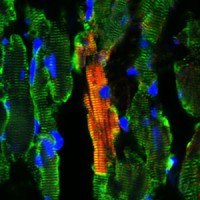The production was made from induced stem cells derived from patients with fatal congenital arrhythmia of the CPVT type; The beating heart cells express the defective gene and the clinical features of the disease

Rambam and Technion researchers succeeded in producing cells in the laboratory that can be used to discover new drugs and to understand the developmental processes of congenital arrhythmias.
The research was carried out by Professor Ofer Bina, Professor Yosef Itzkovitz-Eldor, Director of the Department of Women and Maternity at the Rambam Medical Center, and Professor Avraham Lorber, Director of the Pediatric Cardiology Department at Meir Hospital at the Rambam Medical Center. Patients with CPVT (Catecholaminergic polymorphic ventricular tachycardia) took part in the study.
This disease is characterized by cardiac arrhythmias that occur during physical activity or excitement, which can cause the sudden death of the patients at a young age. As part of the study, cells were produced from skin samples of patients with congenital arrhythmia. In the next step, through viral infection, a number of genes were inserted into those cells from the skin, a process that caused the "reprogramming" of the adult cells, and their transformation into induced stem cells
Induced pluripotent stem cells) Similar to embryonic stem cells, the induced stem cells differentiated autonomously into beating heart cells that carried the genetic mutation for the CPVT disease. In the research carried out in the laboratory, it was discovered that, similar to patients, the damaged heart cells display the arrhythmogenic electrical characteristics (arrhythmic generators) of the disease.
According to the researchers, this discovery is extremely important and will enable a deep and good understanding of the cellular processes that cause this congenital arrhythmia. In addition, this innovative study will allow researchers to test the effectiveness of new antiarrhythmic drugs, as well as "personalized medicine" of effective drugs for each patient, through a preliminary test of the effect of potential drugs on arrhythmias formed in the heart cells of that patient.
The research published in the scientific journal Journal of Cellular and Molecular Medicine is part of the doctoral theses of Atara Novak (the first author of the article) and Lily Bard. Other partners in the research are: Dr. Naama Zavi-Levin, Revital Schick and Dr. Ronit Streichman.

2 תגובות
Can human life expectancy be extended by significant orders of magnitude?